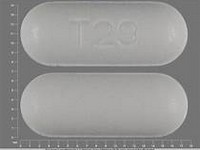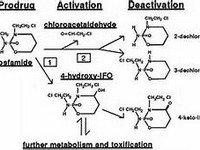Carbamazepine

Carbamazepine
CLINICAL USE
All forms of epilepsy except absence seizuresTrigeminal neuralgia Prophylaxis in manic depressive illness DOSE IN NORMAL RENAL FUNCTION
Epilepsy: initially 100–200 mg 1–2 times daily, increased to maintenance of 0.4–1.2 g daily in divided doses; maximum 1.6–2 g dailyRectal: maximum 1 g daily in 4 divided doses for up to 7 days useTrigeminal neuralgia: initially 100 mg 1–2 times daily; usual dose 200 mg 3–4 times daily; maximum 1.6 g/day; reduce dose gradually as pain goes into remissionProphylaxis in manic-depressive illness: 400–600 mg daily in divided doses, maximum 1.6 g/day PHARMACOKINETICS
Molecular weight :236.3 %Protein binding :70–80 %Excreted unchanged in urine : 2 Volume of distribution (L/kg) :0.8–1.9half-life – normal/ESRD (hrs) :5–26/Unchanged DOSE IN RENAL IMPAIRMENT
GFR (mL/MIN)
20 to 50 : Dose as in normal renal function 10 to 20 : Dose as in normal renal function <10 : Dose as in normal renal function DOSE IN PATIENTS UNDERGOING RENAL REPLACEMENT THERAPIES
CAPD :Not dialysed. Dose as in normal renal function HD :Not dialysed. Dose as in normal renal functionHDF/high flux :Unknown dialysability. Dose as in normal renal functionCAV/VVHD :Not dialysed. Dose as in normal renal function IMPORTANT DRUG INTERACTIONS
Potentially hazardous interactions with other drugsAnalgesics: effect enhanced by dextropropoxyphene; decreased effect of tramadol and methadoneAntibacterials: reduced effect of doxycycline; concentration increased by clarithromycin, erythromycin and isoniazid; increased risk of isoniazid hepatotoxicity; concentration reduced by rifabutin; concentration of telithromycin reduced – avoid concomitant useAnticoagulants: metabolism of coumarins accelerated (reduced anticoagulant effect)Antidepressants: antagonism of anticonvulsant effect; concentration increased by fluoxetine and fluvoxamine; concentration of mianserin, mirtazepine, paroxetine and tricyclics reduced; avoid concomitant use with MAOIs; concentration reduced by St John’s wort – avoid concomitant useAntifungals: concentration possibly increased by fluconazole, ketoconazole and miconazole; concentration of itraconazole, caspofungin, posaconazole and voriconazole possibly reduced, avoid with voriconazole, consider increasing caspofungin doseAntimalarials: chloroquine, hydroxychloroquine and mefloquine antagonise anticonvulsant effectAntipsychotics: antagonism of anticonvulsant effect; reduced concentration of aripiprazole (increase aripiprazole dose), haloperidol, clozapine, olanzapine, quetiapine, risperidone and sertindole; avoid concomitant use with other drugs that can cause agranulocytosisAntivirals: reduced concentration of amprenavir, darunavir, indinavir, lopinavir, nelfinavir and saquinavir; concentration possibly increased by ritonavir; concentration of both drugs reduced in combination with efavirenzCalcium-channel blockers: effects enhanced by diltiazem and verapamil; reduced effect of felodipine, isradipine and probably dihydropyridines, nicardipine and nifedipineCiclosporin: metabolism accelerated (reduced ciclosporin concentration)Corticosteroids: reduced effect of corticosteroidsDiuretics: increased risk of hyponatraemia; concentration increased by acetazolamide; reduced eplerenone concentration – avoid concomitant useHormone antagonists: metabolism inhibited by danazol; accelerated metabolism of gestrinone and possibly toremifeneOestrogens and progestogens: reduced contraceptive effectUlcer-healing drugs: concentration increased by cimetidine ADMINISTRATION
Reconstition
– Route
Oral, rectal Rate of Administration
–Comments
When switching a patient from tablets to liquid the same total dose may be used, but given in smaller more frequent doses125 mg suppository is equivalent to 100 mg of tablets OTHER INFORMATION
Important to initiate carbamazepine therapy at a low dose and build this up over 1–2 weeks, as it autoinduces its metabolismMay cause inappropriate antidiuretic hormone secretionTherapeutic plasma concentration range: 4–12 micrograms/mL ( 20 to 50 micromol/L at steady state).
See how to identify renal failure stages according to GFR calculation
See how to diagnose irreversible renal disease
Home









